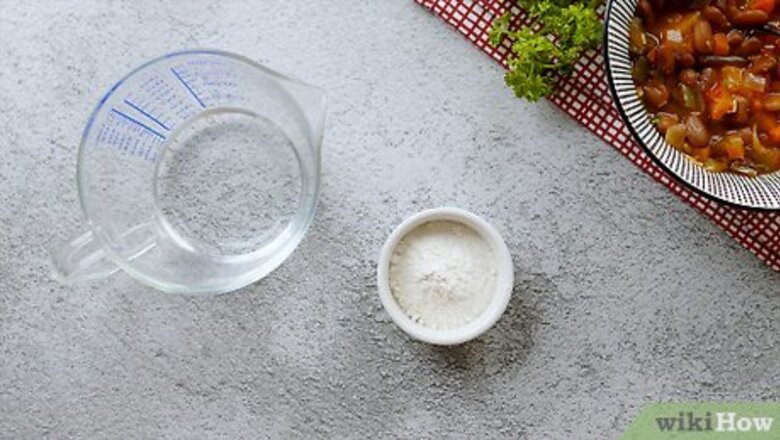
views
Use a Standard Thickening Method
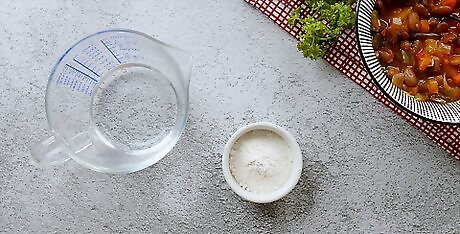
Use flour. Alternatively use unflavored protein powder (available at drugstores, and some grocery stores) for thickening low carb chili. Add a slurry made from 1/4 cup (60 ml) cold water (or dip out some of the chili juice to use) and 2 Tbsp (30 ml) flour. Mix the flour and water in a separate bowl, beating well with a fork so that the resulting thickener is smooth and without lumps. Add the flour mixture to the chili and cook over medium to medium-high heat on the stovetop, stirring constantly, until the liquid boils and thickens. This should only take a few minutes. Continue cooking and stirring an additional minute after the chili thickens so that the flour is completely combined with the chili. Otherwise, you might be able to detect hints of flour in the flavor of the chili. For larger batches of chili in which the excess liquid equals 2 cups (500 ml) or more, double the amount of flour and water you use. While flour is a flavorless thickener, some believe that using too much flour and water in your chili can dull and dilute the flavor, making it less potent.
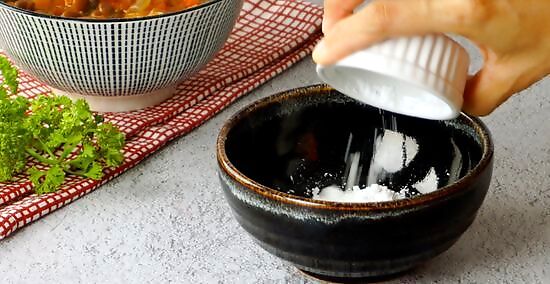
Create a cornstarch slurry. Mix together 1 Tbsp (15 ml) cornstarch with 1 Tbsp (15 ml) cold water to add to the chili. Beat the cornstarch and water together thoroughly in a small, separate bowl before adding it to the chili. Make sure that there are no lumps. Stir the cornstarch slurry into the warm chili and heat over medium to medium-high heat until the mixture bubbles and thickens. You should see results within a few minutes. Add more cornstarch and water, if needed. If the chili is still not thick enough, you can create more of the slurry to add in. Large batches with more than 2 cups (500 ml) of excess liquid may need twice the amount of cornstarch slurry, if not more. Let the chili cook for an additional 2 minutes after it thickens so that the cornstarch breaks down completely. Otherwise, it could tint the flavor of the chili. Note that cornstarch gives liquids a slightly glossy appearance. Also note that cornstarch is flavorless and will not alter the taste of the chili, though if you add too much of the slurry, it can dilute the flavor and tone it down.
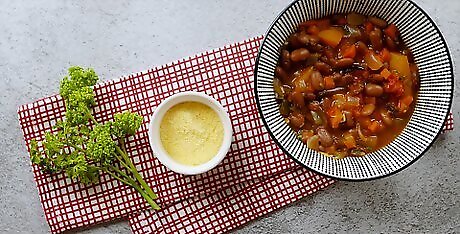
Try cornmeal or masa harina. Adding 2 to 3 Tbsp (30 to 45 ml) of either cornmeal or masa harina straight to the chili will also thicken the liquid. Add the cornmeal or masa harina to the chili without mixing any water into it first. Mix it in thoroughly so that it absorbs some of the liquid, thickening it up. Let the chili simmer for an additional 5 to 7 minutes after adding the thickener. Fine cornmeal resembles flour but has a strong corn taste, as it is ground directly from corn. Masa harina also has a strong taste, since it is ground straight from dried hominy, which is a product of corn. Adding either cornmeal or masa harina will affect the taste of the chili. It can impart the taste of polenta or tortilla shells to the liquid. While many individuals may find that the added taste complements the flavor of the chili, others argue that it pollutes the taste, instead.
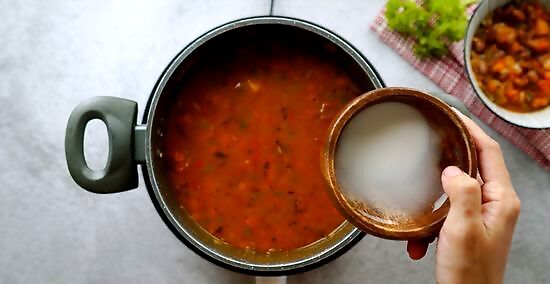
Opt for arrowroot. Add 1 tsp (5 ml) of arrowroot mixed with about 1 tsp (5 ml) of cold water to the chili and let simmer until thick. Mix the water and arrowroot separately in a small bowl until smooth. After adding the slurry, allow the chili to come to a simmer, stirring constantly. The liquid should thicken quickly. Arrowroot refers to a starch obtained from the arrowroot plant. It can usually be found near the cornstarch. Arrowroot is flavorless and potent, so only a small amount is needed. Since a small amount is used, it should not dilute the taste too much, making it a favorite among many chili fans. Like other starches, arrowroot will add a slight gloss to the appearance of the chili liquid.
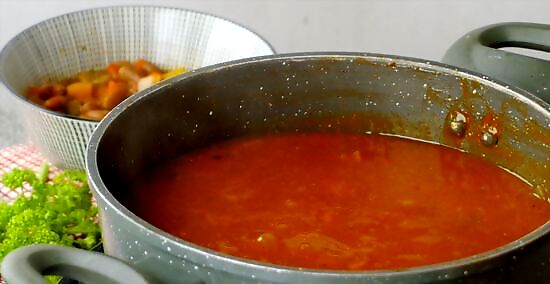
Let the chili reduce. Remove the lid from your pot of chili and let it simmer for an additional 30 to 60 minutes. You can bring up the temperature to reduce the amount of time, bringing it closer to 30 minutes. Do not let the chili reach a full boil, though. If you keep the chili cooking on low at a slow simmer, it may take closer to 60 minutes before significant reduction is noticed. This process uses evaporation to reduce the amount of liquid in the chili. Removing the lid maximizes the effect by allowing more steam to escape. The remaining chili liquid will have a stronger, more concentrated flavor after the reduction is complete.
Emulsify
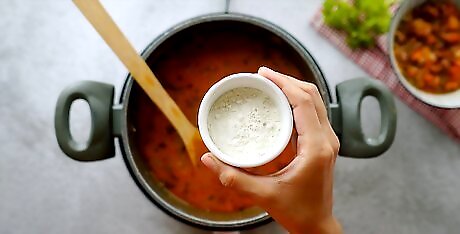
Buy an emulsifier. An emulsifier, such as lecithin (commonly available in health food sections) will help disperse the fat throughout the chili, adding a slightly thicker, rich mouthfeel to every bite without actually increasing viscosity much.
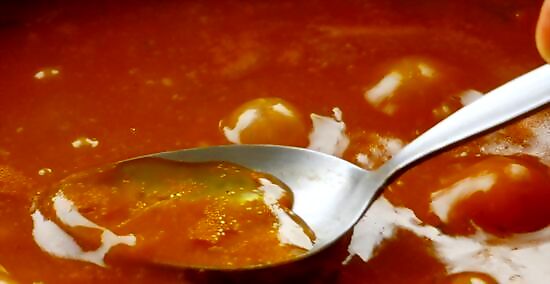
Discard excessive fat before emulsifying. This process makes the fat more appetizing, if you were going to keep it, but adds fat if you'd otherwise drain it off.
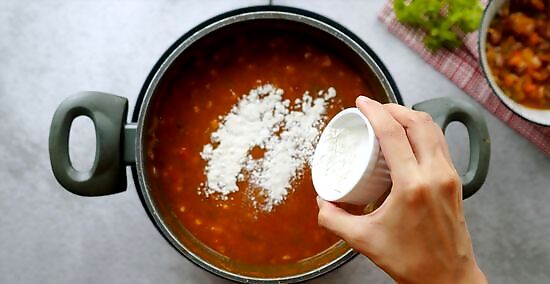
Add the emulsifier conservatively: a teaspoon for a little pot, a tablespoon for a big one.
Thicken with Chili Ingredients
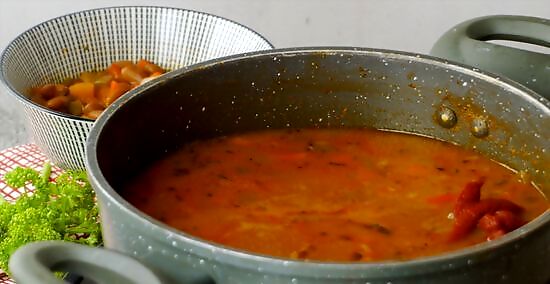
Mix in tomato paste. Stir a 6-oz (180-ml) can of tomato paste into the chili during the final 30 minutes of cooking, stirring well to combine. Since the vast majority of chili is tomato-based, adding additional tomato paste to the chili does not introduce much new flavor to the chili. It can remove some of the "kick," however, so you may need to bump up the amount of seasoning you use to balance things out. Since tomato paste can be somewhat bitter, you may also want to add 1 tsp (5 ml) to 1 Tbsp (15 ml) of granulated sugar to the chili, as well. The sugar will balance out the bitterness and add a mild sweetness to the chili. If you only want the chili to become a little thicker, add the tomato paste slowly, using about 1/3 of the can every 10 minutes or so. Stir well after each addition. This will give you an idea of how thick the chili is becoming and can prevent your chili from becoming too thick.
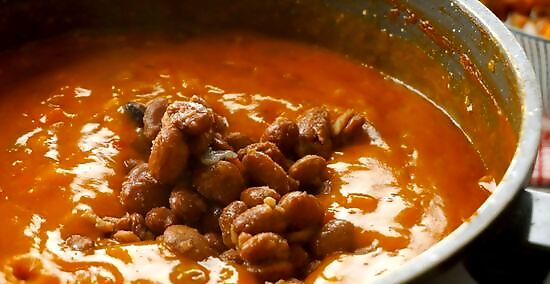
If your chili has beans in it, strain out about 1/2 cup (125 ml) of the beans and re-fry, or puree them in a food processor or blender. Return these beans to the chili, mix in, and let cook for a few minutes, stirring occasionally until well warmed. Be careful when pureeing hot food, especially if using a blender. The puree can spin out of the blender and cause burns if you do not keep the lid held down with a thick towel. If you expect the chili to be too thin before you start making it, you can make the process easier on yourself by pureeing 1/2 cup (125 ml) or more of the beans before adding them to the chili. Add home-cooked or canned beans. They do not need to be mashed up in order to make your chili seem thicker. Use a can of pinto or kidney beans.
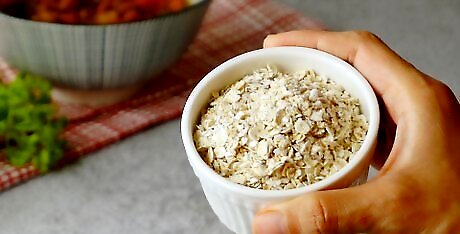
Add quick oats. Inexpensive canned "No Beans" chili, thick and popular for hot dog topping, is not all meat. Its non-meat ingredient is oatmeal! (Really, read the label). Dried oats, for oatmeal, absorb a lot of liquid and form distinct moist kernels transitioning to soft but not completely mushy ones as they cook. Check the canister for the amount of finished oatmeal a certain amount of dried oats will make by absorbing liquid, and add conservatively. Cook for at least a few minutes for "quick" (parboiled) oats; at least a half hour for "old-fashioned" oats.
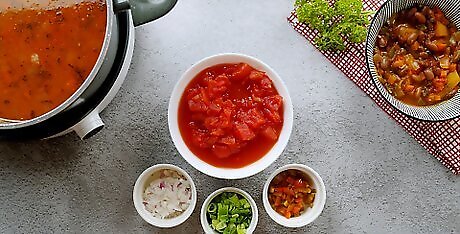
Add other solid ingredients. Sometimes the liquid itself is thick enough, but the chili has too few solid ingredients and is not chunky enough. In these instances, feel free to alter the recipe simply by adding more solids. But bear in mind that many "solids" have a lot of liquid in them and will soften with or even release it in cooking. Adding precooked items like drained tomatoes, onion, corn, beans or okra, etc. toward the end of the cooking makes the chili chunky, but adding them midway through and cooking much longer can bring out additional juices and make the chili soupy. Add uncooked noodles to simmering chili to take up liquid. Let it simmer for 10 to 15 minutes to heat and check the noodles until they are as tender or al dente (firm) as you like. Add diced tomatoes -- either canned or fresh. Let this simmer gently for 10 minutes or so to heat well, or longer to soften the fresh tomatoes, if you wish. Use diced peppers, such as 1/2 to 1 bell pepper, diced, for a mild, sweet flavor. Use 1 chili pepper to add more heat to the chili, if desired. Let it simmer, gently, for an additional 5 to 10 minutes. Stir in minced or powdered, dried onion and let it simmer to absorb water. Onion adds a spicy-sweet flavor but does not linger on the breath like raw onion would do.
Thicken Upon Serving
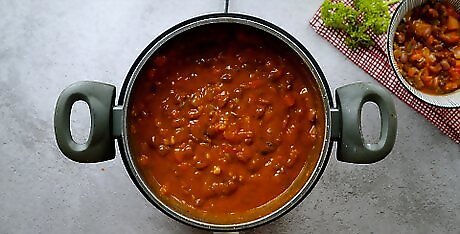
Wait until the end for this method. If you have a thin chili pot that doesn't spread heat well, don't like to stir the chili, or want extra thick chili, it's best to wait until the end because thickening will decrease convection that spreads heat throughout the chili mass without creating hot spots that can scorch.
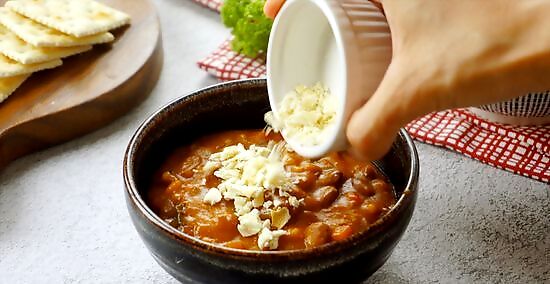
Crumble a few saltine crackers and stir them into your individual serving of chili. Start with 3 or 4 crackers, adding more to bring the chili to your desired thickness. You could also use miniature oyster crackers, but it is still a good idea to break them up so that they can absorb more of the liquid. To add an interesting dimension of flavor, you could also use flavored gourmet crackers. Try garlic-and-cheese, green onion, or four-cheese flavored crackers, for instance.
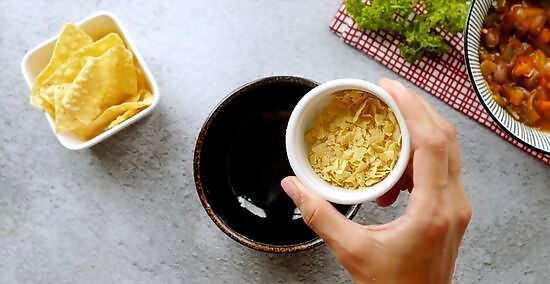
Try crushed corn chips. Add a layer of crushed corn chips into your bowl before ladling the chili in. Stir to combine. While corn chips do not thicken the chili quite as much as crackers do, many prefer the flavor of corn chips to the flavor of crackers for chili. While they do not thicken the liquid itself, they do thicken the overall texture of the chili by adding another solid to it.
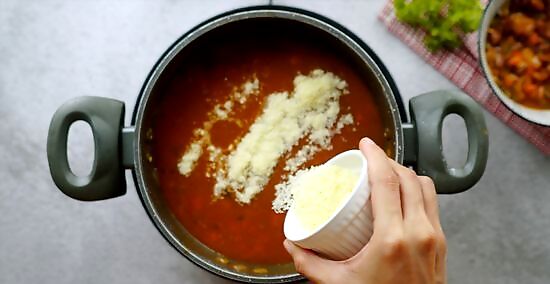
Stir in potato flakes. You can sprinkle 1 to 2 Tbsp (15 to 30 ml) of dried potato flakes into a large individual serving of chili while it is still hot. The potato flakes will lighten the color of the chili slightly. They may also alter the flavor, giving it a heartier taste, but the difference is not especially dramatic.
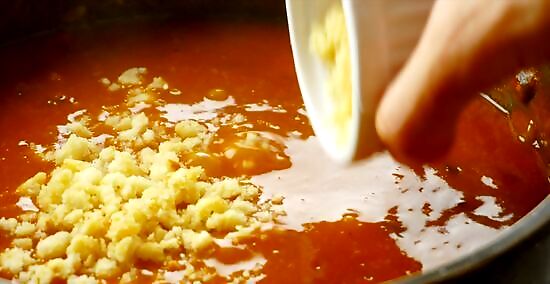
Add crumbled cornbread, such as a single muffin or slice of cornbread into the chili and stir a little. The cornbread will absorb some of the liquid, making the chili seem thicker overall.
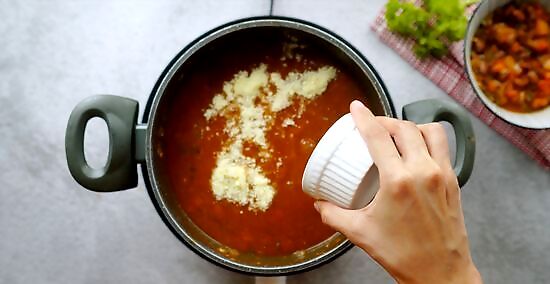
Stir in grated cheese, chipped-up soft cheese or cheese dip/sauce. The cheese adds rich, creamy smoothness to the lucky partaker's palate.
















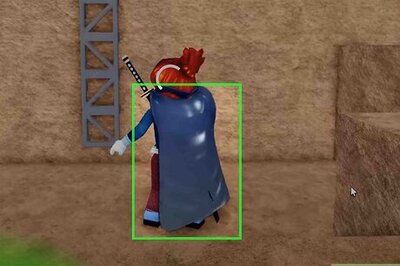


Comments
0 comment